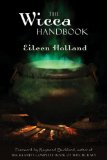
The Wicca Handbook
, by Eileen Holland
Weiser Books, 9781578634385, 309 pp. (including index, and glossary), 2008
The introduction to this book describes it as “both a tutorial for new witches and a reference book for experienced practitioners”1, and the foreword described it as an introduction, yet I feel I must disagree with idea that this book is meant for the absolute beginner. One of the first things I noticed about this supposedly introductory book is the lack of depth on many of the included topics, and the assumption on the reader’s knowledge. For example, Holland recommends meditation as one of the foundations required to perform successful magic as a witch, which I agree with, but to quote:
“To meditate, you must get comfortable in a place where you will not be interrupted, then enter a state of deep relaxation, one step away from sleep. Clear your mind, then set it free to wander.”2
That is the full extent of her instructions on how to meditate, which even as a description of the concept I find woefully inadequate. Sadly that’s not the only time she doesn’t explain something or only uses it in context. She alternates between besom and broomstick, without explaining they are the same, she mentions some spells or herbs that are good as floorwashes or mojo bags, but does not explain what either is. Another example is:
“When you can feel the creative energy of the universe, the urge toward life, draw it into yourself. Don’t be discouraged if it takes you some time to learn to do this.”3
The student witch is not supposed to be discouraged if it takes them a while to learn to do something, the author doesn’t explain, she doesn’t even give a simple visualization like a ball of light entering you, she leaves no instructions. Again, I feel the chance to write a better book, and give the student a bit more help has been overlooked. She lists a few spells, and loads of correspondences to create your own spells with, but doesn’t really give the reader advice on how to create their own spells, other than through dissecting her examples. While I see this book being beneficial to people earlier on a Wiccan or Witch path, as their “introduction” I feel this book isn’t appropriate.
Aside from some of the lack of actual beginner content, the book did have its good parts. The author tried to take a balanced approach to the debate of Wicca being a modern religion or an ancient religion, which keeps the book accessible to folks who want to believe it is an ancient faith, and people who believe it as a modern creation. For those who like correspondence, over half of the book is taken up with a wide variety of correspondences. My only complaint with the correspondences being my usual complaint with most correspondences, she does not tell you how the associations are made, so you are left with her list, and no reasoning, as opposed to explanations on how to create your own system.
I see the book as being potentially beneficial for witchy folk, but counter to the proposed purpose of the book, I don’t believe it would serve well as an introduction, but would work if someone is already moving down that path.








